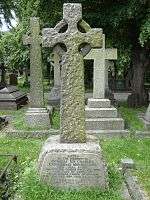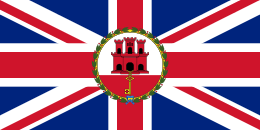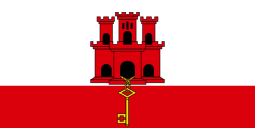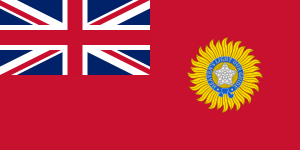Sir Charles Monro, 1st Baronet
General Sir Charles Carmichael Monro, 1st Baronet, GCB, GCSI, GCMG (15 June 1860 – 7 December 1929) was a British Army General in First World War. He held the post of Commander-in-Chief, India in 1916-1920. From 1923 to 1929 he was the Governor of Gibraltar.
Sir Charles Monro, Bt | |
|---|---|
 | |
| Born | 15 June 1860 At sea on the Maid of Judah |
| Died | 7 December 1929 (aged 69) Westminster, London, England, United Kingdom |
| Allegiance | United Kingdom/British Empire |
| Service/ | British Army |
| Years of service | 1878–1920 |
| Rank | General |
| Unit | Queen's Royal Regiment (West Surrey) |
| Commands held | 13th Brigade 2nd London Division 2nd Division I Corps Third Army Mediterranean Expeditionary Force First Army Commander-in-Chief, India |
| Battles/wars | Second Boer War First World War Third Anglo-Afghan War |
| Awards | Baronet Knight Grand Cross of the Order of the Bath Knight Grand Cross of the Order of St Michael and St George Knight Grand Commander of the Order of the Star of India |
| Other work | Governor of Gibraltar |

Early military career
He was the youngest son of Henry Monro and Catherine Power. Educated at Sherborne School and the Royal Military College, Sandhurst, Monro was commissioned into the 2nd Regiment of Foot as a second lieutenant on 13 August 1879.[1][2][3] He was promoted to lieutenant on 15 May 1881 and to captain on 24 July 1889.[4][5]
He attended the Staff College, Camberley from 1889 to 1890[6] and, promoted to major on 23 February 1898,[7] he served as a brigade major until he was appointed a deputy assistant adjutant general on 15 April 1899.[8] He vacated that appointment in February 1900,[9] as he went to South Africa to serve in the Second Boer War, where he was present at the Battle of Paardeberg in 1900.[1] Promoted to temporary lieutenant-colonel in 1900, he was brevetted to lieutenant-colonel on 29 November 1900.[10] On 28 March 1903, he was promoted to the substantive rank of lieutenant-colonel and appointed commandant of the School of Musketry.[11][12] Promoted to colonel in 1906, he was appointed Commander of 13th Infantry Brigade in Dublin on 12 May 1907, with the temporary rank of brigadier-general.[1][13] Promoted to major-general on 31 October 1910, on 31 March 1912 he became General Officer Commanding 2nd London Division.[14][15]
First World War
In the early days of the First World War on 5 August 1914, Monro was deployed to France as General Officer Commanding 2nd Division, which played an important part in the First Battle of Ypres. [1][16] He led with what a subordinate described as "the gift of personal magnetism". [17] On 27 December 1914 he became General Officer Commanding I Corps, with the temporary rank of lieutenant-general.[18] He was made General Officer Commanding Third Army on 15 July 1915 with the temporary rank of general. [1][19] He was promoted to the permanent rank of lieutenant-general on 28 October. [20]
In October 1915, the seventh month of the Gallipoli Campaign, General Ian Hamilton was dismissed as Commander-in-Chief of the Mediterranean Expeditionary Force. Charles Monro was sent to evaluate what had been achieved and to recommend next steps for the campaign. [21] The Allied position had been drastically altered by the entry of Bulgaria into the war and the Central Power's subsequent swift conquest of Serbia, which opened the railway from Germany to Istanbul for transporting heavy guns and ammunition. [22] After three days conferring and inspecting the three beachheads, Munro cabled Secretary of State for War Herbert Kitchener to recommend evacuating "the mere fringe of the coast-line" that had been secured. [23] Kitchener would not authorize a withdrawal, which was strongly opposed by the Navy, instead he came to the Middle East to see for himself. After arriving on 9 November 1915 he and Monro toured the fronts, landing on open beaches since there were no ports. Then they visited the Allied lines in Greek Macedonia, where reinforcements were badly needed. On 17 November 1915 Kitchener agreed to evacuate and put Monro in control as Commander-in-Chief Mediterranean. The architect of the Dardanelles campaign, Winston Churchill, resigned from the government in protest, memorably describing Monro as "He came, he saw, he capitulated" [24] The War Committee dithered, finally on 7 December agreeing to evacuate two of the bridgeheads. Their reluctance was understandable: Ottoman guns were able to strike the landing zones on all three beachheads, so evacuation casualties were estimated at thirty to forty per cent — Monro requested fifty-six hospital ships. On 19-20 December the two beachheads were evacuated without a single casualty, leaving behind only some spiked artillery and slaughtered mules. It was a masterly display by the commanders of the beachheads and their staffs. After further pressure from Monro, the evacuation of the remaining beachhead at Cape Helles was authorized on 28 December with the agreement of the French who had troops there. It was skillfully executed on the night of 8-9 January 1916, again astonishingly without casualties. They had taken off 83,048 men, 4,695 horses and mules, 1,718 vehicles, and 186 heavy guns. [25]
In 1916 Monro briefly commanded the British First Army in France before becoming Commander-in-Chief India later that year.[1] He was a fine choice, because his "Standard was whether a man was an Empire-builder." [26] One of his responsibilities was the campaign in Mesopotamia. On 1 August 1916 British Chief of Staff William Robertson ordered him to “keep up a good show” in Mesopotamia but not to make any further attempts to take Baghdad — this restriction was overruled on the War Committee by Curzon and Chamberlain. On his way to India Monro inspected the forces in Mesopotamia commanded by General Maude. After receiving Monro's favorable report on 18 September 1916 the War Committee authorized Maude to attack. [27] On 1 October 1916, Monro was promoted to the substantive rank of general. [28] Baghdad was taken on 11 March 1917. In off hours Monro continued to charm with his "whimsical, almost fantastic type of humour." [29]
Later life
In May 1921, Monro was created a Baronet, of Bearcrofts in the Shire of Stirling.[30] In 1923 Monro was appointed Governor of Gibraltar.[1] In 1915, he married Mary O'Hagan, youngest daughter of Thomas O'Hagan, 1st Baron O'Hagan and his second wife Alice Towneley: they had no children. Monro died in 1929, his body being buried at Brompton Cemetery in London.[31]
Honours
British
- Knight Grand Cross of the Order of St. Michael and St. George (GCMG): 1 January 1916[32]
- Knight Grand Cross of the Order of the Bath (GCB): 1 January 1919[33] (KCB: 18 February 1915;[34] CB: 1906 Birthday Honours[35])
- Knight Grand Commander of the Order of the Star of India (GCSI): 3 June 1919[36]
- Baronet of Bearcrofts in the Shire of Stirling: 12 May 1921[30]
Others
- Grand Officer of the Legion of Honour of France: 10 September 1915[37]
- Grand Cordon of the Order of the Rising Sun of the Empire of Japan: 17 May 1919[38]
References
- "Monro, Sir Charles Carmichael, baronet (1860–1929), army officer | Oxford Dictionary of National Biography". www.oxforddnb.com.
- Barrow, Gen. Sir George (1931). The Life of General Sir Charles Carmichael Monro. London: Hutchinson & Co.
- "No. 24751". The London Gazette. 12 August 1879. p. 4900.
- "No. 25007". The London Gazette. 23 August 1881. p. 4347.
- "No. 25970". The London Gazette. 3 September 1889. p. 4787.
- http://www.queensroyalsurreys.org.uk/colonels/036.html
- "No. 26941". The London Gazette. 22 February 1898. p. 1118.
- "No. 27074". The London Gazette. 25 April 1899. p. 2629.
- "No. 27164". The London Gazette. 13 February 1900. p. 1002.
- "No. 27306". The London Gazette. 19 April 1901. p. 2705.
- "No. 27546". The London Gazette. 24 April 1903. p. 2618.
- "No. 27551". The London Gazette. 12 May 1903. p. 2987.
- "No. 28024". The London Gazette. 24 May 1907. p. 3593.
- "No. 28433". The London Gazette. 4 November 1910. p. 7908.
- "No. 28600". The London Gazette. 19 April 1912. p. 2792.
- "No. 28921". The London Gazette (Supplement). 29 September 1914. p. 7787.
- Barrow, General Sir Charles (1931). The life of General Sir Charles Carmichael Monro. London: Hutchinson. p. 113.
- "No. 29048". The London Gazette (Supplement). 22 January 1915. p. 785.
- "No. 29267". The London Gazette (Supplement). 17 August 1915. p. 8247.
- "No. 29341". The London Gazette (Supplement). 26 October 1915. p. 10615.
- Crowley, Patrick (2016). Loyal to Empire ; The :Life of General Sir Charles Monro, 1860-1929. Stroud: The History Press. pp. 202–222.
- Barrow 1931, pp. 61-86.
- Barrow 1931, p. 65.
- Churchill, Rt. Hon. Winston S. (1949) [1923]. The World Crisis. New York: Charles Scribner's Sons. p. 532.
- Gilbert, Martin (1994). The First World War. New York: Henry Holt. p. 213.
- Barrow 1931, p. 271
- Woodward 1998, pp. 118-9.
- "No. 30129". The London Gazette (Supplement). 12 June 1917. p. 5850.
- Barrow 1931, p. 266.
- "No. 32323". The London Gazette. 13 May 1921. p. 3846.
- "brompton.org - Diese Website steht zum Verkauf! - Informationen zum Thema brompton". www.brompton.org.
- "No. 29507". The London Gazette (Supplement). 14 March 1916. p. 2872.
- "No. 31097". The London Gazette (Supplement). 31 December 1918. p. 81.
- "No. 29074". The London Gazette (Supplement). 16 February 1915. p. 1686.
- "No. 27926". The London Gazette (Supplement). 26 June 1906. p. 4460.
- "No. 31379". The London Gazette (Supplement). 30 May 1919. p. 7046.
- "No. 29290". The London Gazette. 10 September 1915. p. 8986.
- "No. 31345". The London Gazette (Supplement). 16 May 1919. p. 6208.
Further reading
| Wikimedia Commons has media related to Sir Charles Monro. |
| Wikiquote has quotations related to: Charles Monro |
- Crowley, Patrick. "Loyal to Empire: The Life of General Sir Charles Monro, 1860–1929", Stroud, United Kingdom: The History Press, 2016, ISBN 9780750965996
- Woodward, David R. "Field Marshal Sir William Robertson", Westport Connecticut & London: Praeger, 1998, ISBN 0-275-95422-6

| Military offices | ||
|---|---|---|
| Preceded by Vesey Dawson |
GOC 2nd London Division 1912–1914 |
Succeeded by Thomas Morland |
| Preceded by Henry Lawson |
General Officer Commanding the 2nd Division August 1914 – December 1914 |
Succeeded by Henry Horne |
| Preceded by Douglas Haig |
GOC I Corps December 1914 – July 1915 |
Succeeded by Hubert Gough |
| Preceded by New creation |
Commander of the British Third Army July 1915 – September 1915 |
Succeeded by Sir Edmund Allenby |
| Preceded by Sir John Maxwell |
General Officer Commanding the British Troops in Egypt October 1915 – January 1916 |
Succeeded by Sir Archibald Murray |
| Preceded by Sir Ian Hamilton |
Commander of the Mediterranean Expeditionary Force October 1915 – January 1916 | |
| Preceded by Sir Henry Rawlinson |
Commander of the British First Army January 1916 – October 1916 |
Succeeded by Sir Henry Horne |
| Preceded by Sir Beauchamp Duff |
Commander-in-Chief, India 1916–1920 |
Succeeded by The Lord Rawlinson |
| Preceded by Sir Edward Hamilton |
Colonel of the Queen's Royal Regiment (West Surrey) 1920–1929 |
Succeeded by Sir Wilkinson Bird |
| Preceded by B. T. L. Thomson |
Honorary Colonel of the 23rd London Regiment 1922–1928 |
Succeeded by The Lord Astor of Hever |
| Government offices | ||
| Preceded by Sir Horace Smith-Dorrien |
Governor of Gibraltar 1923–1928 |
Succeeded by Sir Alexander Godley |
| Baronetage of the United Kingdom | ||
| Preceded by New creation |
Baronet (of Bearcrofts) 1920–1929 |
Succeeded by Extinct |
| Heraldic offices | ||
| Preceded by Sir George Callaghan |
King of Arms of the Order of the Bath 1920–1929 |
Succeeded by Sir William Pakenham |


.svg.png)
